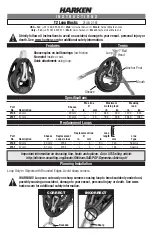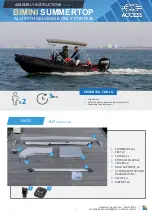
Section 4 – Installation Information
Telemotive Laser Guard Instruction Manual – October 2009
9
CAUTION
THE LASER CONTROL UNIT AND RELAYS
ARE NOT RATED AS EXPLOSION PROOF. THE
UNIT MUST NOT BE INSTALLED IN EXPLO-
SIVE ENVIRONMENTS UNLESS APPROPRIATE
SECONDARY ENCLOSURE MEASURES ARE
TAKEN.
4-1.
Mounting Location Considerations.
Ensure the mounting location is as far as possible
from exposed trolley wires and sources of
electromagnetic or radiated noise.
If possible, avoid installing receiver unit to a surface
where high vibration or shock is present. If this
cannot be avoided, use appropriate shock mounts.
4-2.
Line Input Considerations.
Check the system drawings for proper line input
voltage. If there is any question as to proper line
input voltage contact Telemotive before applying
power to the unit.
WARNING
THE UNIT MUST BE WIRED TO THE CORRECT
VOLTAGE, FAILURE TO DO SO MAY DAMAGE
THE SYSTEM.
NOTE
THE UNIT SHOULD NOT BE CONNECTED TO
LINES CONTAINING EXCESSIVE POWER UP
TRANSIENTS OR CONTINUOUS COMMUTA-
TOR NOISE. A LINE CONDITIONER MAY BE
NECESSARY IN SOME INSTALLATIONS.
4-3.
Wiring Considerations.
1.
Do not connect or disconnect wiring, or perform
circuit checks while the power is turned on.
2.
The motor wiring shall be in a separate metal
conduit from the power wiring, which shall also
be in metal conduit.
3.
Low voltage wires shall be wired with Class 1
wiring.
4.
Control wiring shall be in separate conduit and
shall be kept as short as possible.
5.
Control wiring for stepless devices shall be
shielded twisted pair. The shield should be
grounded at both ends.
6.
All terminals shall be tightened to specified
terminal torque (4.4 IN-LBS. unless otherwise
specified).
7.
Please observe National Electric Code (NEC)
when wiring electrical devices.
8.
When cutting holes in cabinet take care to
prevent metal filings from shorting circuitry.
Remove excess metal screws, metal filings and
wire clippings from inside of unit.
9.
Inspect to make sure no exposed wire has contact
with any other wiring or terminals.
10.
Suppressors are strongly recommended on all
contactors.
4-4.
Mechanical Installation
The Anti-Collision System measures the distance
between the laser unit's lens and the target surface.
There must be no projections on the wall or the
overhead crane that may extend in front of either (or
both) the laser unit or the companion target.
Make sure the laser is mounted such that nothing can
come between the laser's view of the target and at
least 5 ft. (preferably 10 ft.) from walls or other
objects that may act as a target. If your particular
installation is a crane-to-crane application, do not
mount the lasers on each crane so that their beam
centers as they face each other are closer than 5 ft.
(preferably 10 ft.) apart.
Determine the mounting position for the laser and the
target such that the center of the laser's faceplate and
the center of the target are the same distance above
the plane the crane rails are in. The laser and target
center point should also be the same distance from
the rails. This is the most important part of a
successful installation since the laser beam must stay
on the target at all range points anywhere in the bay.
Refer to Figures
6-8
,
6-9
and
6-10
for mounting
information.
Install the laser and the target in the positions found
in steps above (refer to
Figure 6-1
). Mount the laser
securely to a solid surface so that the crane’s load or
movement will not affect the laser’s alignment. The
laser should also be mounted as close














































